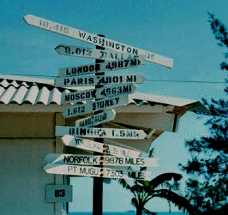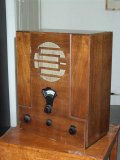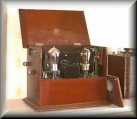Signposting - establishing the location at the beginning of a scene
See also Signposting - further definition
AND Signposting - more - Signposting and establishing location

Key terms: establishing the location, atmos, neutral atmos
Definition of signposting
Signposting is the technique for establishing the location at the beginning of a scene. This is done by effects, spot or FX, and sometimes backed by description.
Discussion of signposting:
Most often these effects or spot are introduced (faded in) at the top of the scene, before the dialogue begins. It is up to the director whether speech begins quickly, or more seconds are needed to strengthen the effect of this signposting on the listener. If a new location, especially an outside location, is being established, the audience will need more time to absorb this information. So the scene will be established in this way: the beach - sea waves - with a seagull (though that is now a cliché), the ambience of a crowded street.
Spot effects can establish a kitchen by sounds of washing up at the sink, or a boiling kettle, and the livingroom by teacups or bottles for alcohol. Signposting has the same function as the establishing shot in film and TV. (See example below.)
Sometimes the signposting has a relatively simple function, especially in 'standard production'. But it can also be used to indicate mood, as symbolism (in the sense of the iconic/symbolic distinction). So the sound of the sea waves symbolizes loneliness or perseverance, depending on context.
Signposting is efficient in returning for the second and further times to the same location. The choice for the director is whether to return to the same signposting device (as washing-up), or vary this. Good writing will link a plot strand to a certain location, for clarity. This is especially to be observed in afternoon plays. For subplot strands, this works well, so that the audience can relocate minor characters in their memory by an easy trigger for recall.
For the director, choosing and presenting the signpost is often a task that demands clarity above subtlety or art. It must be immediately 'read' by the listener, hence the importance of establishing the location:
FX: (FADE IN AND ESTABLISH SEA WAVES AND GULLS CRYING. FADE UNDER DIALOGUE AND KEEP)
Signposting is famous in 'The Archers' where FX birds and animals are regularly used. (There is a history of letters in 'Radio Times' of complaints about unseasonal mistakes, as migrating birds heard too early or too late.)
It is the task of the playwright to offer locations which fit with signposting and open up aural possibilities. These locations are part of what make up, overall, the rhythm of the play.
Make a distinction between the old method of production (pre-stereo) where so much production was in a neutral location and today's stereo standard production, where atmos is used.
Examples of signposting (realism)
dog barking
mowing the lawn
old-fashioned shop door bell
knock on door
walking in outside acoustic
inside car acoustic, with traffic
Domestic Spot
tea cups
spirits bottle and glasses, pouring liquid
plates and cutlery
kettle boiling and then whistling
coffee machine
coffee bean grinder, electric or hand
Machinery
playing stereo system in living room or bedroom
walkman
typewriter
computer keyboard
portable cassette recorder switched on
Hand props
opening envelope
towel or clothes
writing
Further, more detailed examples of signposting (realism):
* Close acoustic of dining-room, vocal reactions from four male and female adults, spot effects of cutlery on plates. First line: It was a magnificent meal, thank you.

